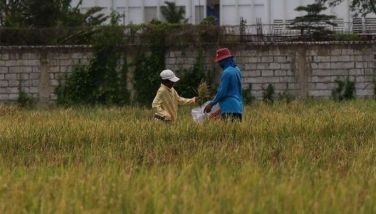Sugar workers

This week we will remember, as we should remember, a lot of what has happened in the past. We remember so we will not forget; we remember so the younger generations will know; we remember so that hopefully, history does not repeat itself; we remember so that we can move forward to better days.
In the US, for instance, Americans commemorated last week the Sept. 11 attacks, commonly known as 9/11, those shattering suicide terrorist attacks carried out by the militant Islamic extremist network al-Qaeda on Sept. 11, 2001, 21 years ago. There were flowers and ceremonies, and speeches and a lot of remembering.
On Saturday, Filipino comfort women, victims of slavery and violence during World War II, now old, tired, and fragile, came out of their homes to commemorate the 30th year since they told the world their stories.
Here in the Philippines, the 50th year of Martial Law will be marked on Wednesday, Sept. 21, and along with it, the recollection of the dark days, etc. Maybe, there will be public protests, maybe there will be a lot of hoarse voices recalling that period in our history.
There are many things to remember about the time, those “days of disquiet and nights of rage,” as writer Pete Lacaba calls it.
The bitter, brutal story of Escalante’s sugar workers
We must also remember what happened on Sept. 20, 1985 – exactly 37 years ago tomorrow – that bitter and brutal story of sugar workers in Escalante, Negros, the country’s sugar capital, especially now that our sugar situation is in a mess.
Escalante is a town in the province of Negros Occidental, the country’s Sugarlandia.
In decades past, the province was made prosperous by the sugar industry.
Since the Spanish colonial period, Negros exported sugar and sugar products. Sugar barons owned the land and they became extremely wealthy. The workers were called the sacadas, usually migrants from neighboring provinces, but many of them remained landless, according to data from Bantayog.
In the 1970s and ‘80s, published articles also chronicled the plummeting price of sugar in the world market that triggered a severe socio-economic crisis.
“As production slowed down, many plantation workers lost their jobs, resulting in widespread poverty. Children died from hunger and malnutrition. When the crony-controlled sugar industry imploded, the sacadas, and even a small number of enlightened landowners, said they had had enough. This triggered protest actions demanding agrarian reform and land distribution, fair wage, and improved government services. As a result, social tension was always high in the province. In those days, Negros was frequently described as a social volcano waiting to explode,” according to articles collated by Wikipedia.
The brewing social unrest led to a series of protests, and on that tragic day of Sept. 20, 1985, some 20 protesting sugar workers were gunned down. The Philippines was placed under Martial Law then.
Here is an excerpt of the Aug. 22, 1996 decision penned by Supreme Court Justice Reynato Puno about that day in 1985:
“The year was 1985, the month, September...One of the biggest protest rallies was blueprinted as a Welga ng Bayan at Escalante, Negros Occidental. It ended in tragedy, which will not easily recede in the mist of our history. Twenty demonstrators were shot dead and 24 others were wounded by the military and para-military forces...”
Justice Puno denied the petition of “civilian government officials, personnel from the Philippine Constabulary and the Integrated National Police, and from the para-military group Civilian Home Defense Force (CHDF).”
“They now come to this Court insisting on their innocence and pleading to be set free. We deny their petition and we warn our military and police authorities that they cannot shoot people who are exercising their right to peacefully assemble and petition the government for redress of grievance,” Justice Puno said in his decision. That was in 1996.
2022
Fast forward to 2022. We are where we are. Our sugar industry is in a precarious situation. We continue to wait for solutions. In Malacanang, President Marcos promised to fix the agriculture sector, the economy, our country. We continue to wait and see.
This week, there will be a lot of remembering.
But as we remember these episodes that marked our past, we should also take stock of what’s been done to prevent a repeat of history. We should also look at every generation’s effort to attain justice for the injustices committed.
But more importantly, we should also seek out those who choose to remember quietly, the families and survivors who are suffering in silence or are too tired to shout in rallies or to join protests; those who quietly leave pastel-color Post-its on the walls of the Bantayog ng mga Bayani, on the most ordinary days bearing messages of pain, anger, and loss.
May we remember them and acknowledge their struggles.
May we also finally see a sugar industry that will be fair and just for all stakeholders, most especially to each and every sacada in Sugarlandia and beyond.
Iris Gonzales’ email address is [email protected].
Follow her on Twitter @eyesgonzales. Column archives at eyesgonzales.com
- Latest
- Trending




























